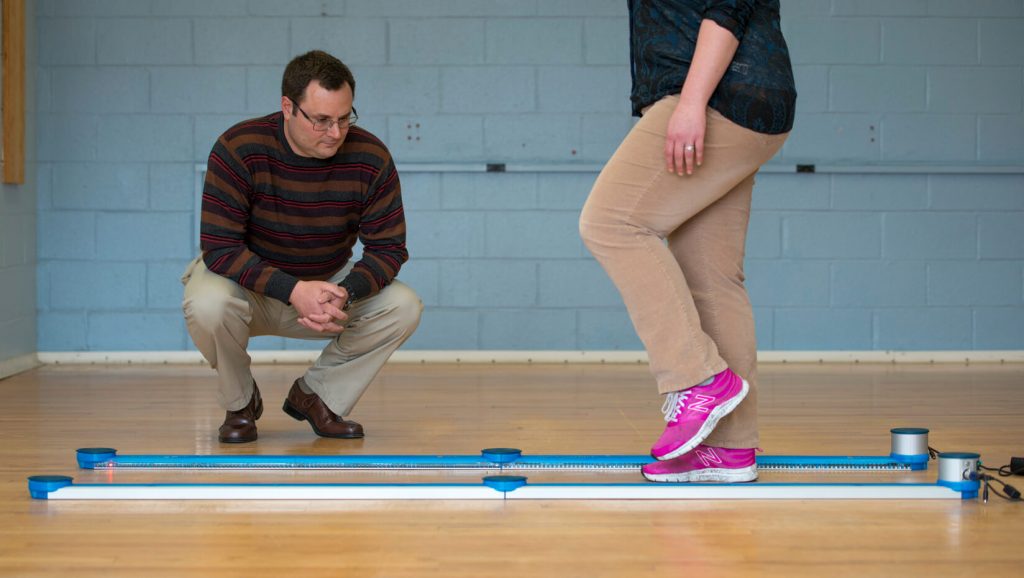UMaine research makes strides toward monitoring post-concussion symptoms

Concussions are big news these days as numerous professional and amateur sports leagues look for ways to ensure the long-term health and safety of players who sustain head injuries.
A team led by researchers from the University of Maine and Logan University recently conducted a pilot study that might lead to a new method of monitoring people who sustain concussions.
Using a device called OptoGait, which evaluates how a person walks, they seek to develop measures of balance that could indicate when a person has sufficiently recovered from a concussion to resume physical activity.
Since loss of balance can be an indicator of a concussion, OptoGait may give athletic trainers and medical professionals additional information about a patient’s symptoms than existing concussion protocols.
“We know that concussions can certainly lead to decreased balance — that’s one of the signs and symptoms,” says Christopher Nightingale, UMaine assistant professor of athletic training and physical education.
“We tested the OptoGait to see what kinds of variations in balance we could find and whether any of those are indications of long-term concussion effects.”
OptoGait was developed by Microgate, a company with headquarters in Italy and New York state that focuses on medical technological development and improving sports performance.
The device, which is simple and easy to use, consists of two parallel tracks resembling skis that are placed on a floor, treadmill or other surface.
Each OptoGait track has 96 LED lights, which line up with a corresponding light on the other track.
When a person steps between the tracks, s/he breaks the path from one light to another, allowing the device to collect information about each step. A USB cable sends the information to a computer, where it’s recorded in real time.
“We can collect information about balance with each step that someone takes, things like gait velocity, how much time your foot is in contact with the floor versus how long it’s picked up, and other markers of balance,” Nightingale says.
For the pilot study, researchers tested the OptoGait on 20 collegiate student-athletes who marched in place between the tracks for 20 seconds at a time.
After an initial test where they marched in a normal, head-forward, eyes-and-ears-open position, the student-athletes did the same test with various types of sensory deprivation designed to simulate concussion symptoms.
Tests included marching with earplugs; marching while blindfolded; marching blindfolded with earplugs; marching with head looking up; marching with head to the left; marching with head to the right; and marching while counting backward from 100 by sevens to add a cognitive challenge.
Test results were compared to those of two standard concussion protocols — the Balance Evaluation Scoring System (BESS) and the Immediate Post-Concussion Assessment and Cognitive Testing (ImPACT) tool.
Although the team did not find strong correlations between the OptoGait and the other tests, the pilot study suggested the device could be another tool for trainers and doctors treating a patient who has had a recent concussion, or who has long-term effects from multiple concussions.
Nightingale says additional testing would be needed to standardize the OptoGait measures, but that the pilot test showed promise.
“Our understanding of concussions is growing daily,” he says. “I think someday what we’ll see in the field of sports medicine is that the term ‘concussion’ will be more a more broad term rather than a specific one. There are different ways that concussions manifest in different people. Having another tool like OptoGait to test for concussion symptoms is a good thing.”
In addition to Nightingale, the testing team included: Craig Mason, UMaine professor of education and applied quantitative methods; Shihfen Tu, associate professor of education and applied quantitative methods; and Stephen Butterfield, retired UMaine professor of education and special education.
The team also included four doctors of chiropractic medicine: Melissa Engelson from the Human Performance Center at Logan University; Jose Ramirez, also from Logan; Laney Nelson, from Camp 4 Human Performance in Utah; Kevin Bardwell from Bardwell Chiropractic in Yarmouth; and Richard Bruns from Bruns Chiropractic in Bangor.
UMaine and Logan University have a three-plus-three arrangement, which allows students to work on their bachelor’s degree for three years in Orono before transferring to Logan to complete their undergraduate degree and get a head start on their doctor of chiropractic degree.
Dr. Bruns earned a bachelor’s degree in psychology from UMaine in 1976 and his doctor of chiropractic degree from Logan. He’s practiced in Bangor for more than 30 years and serves as chair of Logan’s board of trustees.
Bruns says OptoGait holds promise for treating and evaluating patients.
“I now give every patient a brief proprioceptive and balance examination and assess them from that level, and then institute some balance and proprioceptive exercises,” Bruns says.
“Based on the data we can gather from the OptoGait, I do see a day coming where I’ll probably use some kind of system like that to get baseline data on our patients as part of that initial examination.”
The pilot study team also is partnering with UMaine’s Maine Center on Aging to look at ways OptoGait can be used with other populations, including senior citizens at risk of falling.
For seniors, Bruns says, preventing a fall can be a matter of life or death.
“We advise them of the dangers of things like throw rugs and extension cords in their house, but if you can teach them how to attain better balance and coordination and take that fall out of the equation, you may have saved their life,” he says.
The concussion study, “Validation of the OptoGait System for Monitoring Treatment and Recovery of Post-Concussion Athletes,” is in press with the Journal of Chiropractic Medicine.
Contact: Casey Kelly, 207.581.3751
